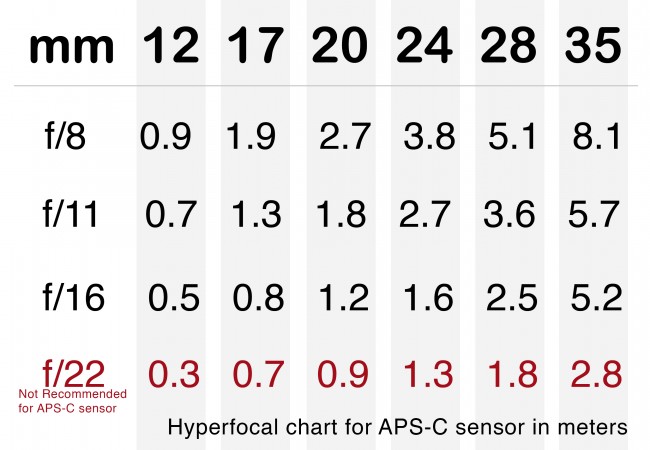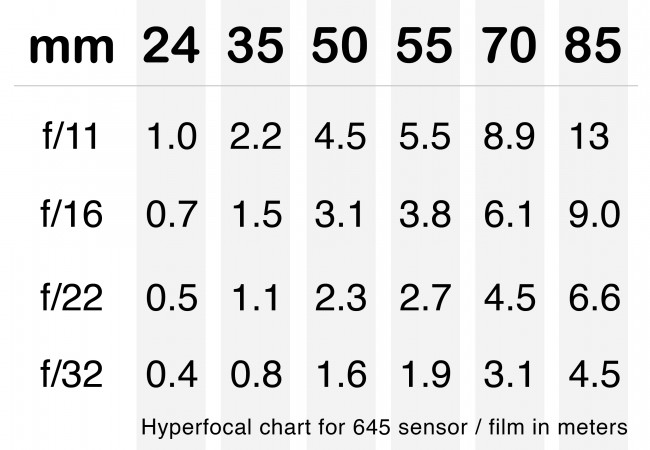I have noticed that more and more photographers purchase prime or as otherwise called standard or non zoom lenses lately. The obvious reason for this is the superior image quality these lenses offer in comparison to the zoom ones. Some photographers actually buy older (manual focus) prime lenses as they can be purchased for really low prices and their quality is still of high standards. I own one of those lenses, the Canon 24mm f/2.8 and I paid less than £150 for it on ebay – the results are superb, image quality is of high standard.
The majority of those lenses have markings to assist you with focusing and hyperfocal distance. However, as most new photographers are used to the autofocus technique and lenses with no markings on them, they can find these old lenses a bit confusing, due to the lack of knowledge on how to use those markings to their benefit.
There are special cards in the market that explain how to use these old lenses – some of them are free to download. However, some of these cards can be confusing, some come with very small printed text and are really hard to see, especially on a dark early morning shoot.
Here are 3 cards I made up for wide angle lenses. These cards are for full frame, APS-C and 645 size sensor / film. Download the one that suits your camera (they are all high resolution cards), print it, laminate it and keep it in your backpack.
Now, how to use the card in plain words.
 Let's say that we want to shoot a landscape with a 24mm lens @ f/16 aperture on a full frame sensor camera. Looking at the card, the lens marking should be set to 1.2 meters. This simply means that the lens will focus 1.2 meters in front of the front element. This will give you a well focused picture with acceptable sharpness from 60cm (always half the focusing distance) all the way to infinity. As long as all elements in the composition are within this distance, then they should be within acceptable focus.
Let's say that we want to shoot a landscape with a 24mm lens @ f/16 aperture on a full frame sensor camera. Looking at the card, the lens marking should be set to 1.2 meters. This simply means that the lens will focus 1.2 meters in front of the front element. This will give you a well focused picture with acceptable sharpness from 60cm (always half the focusing distance) all the way to infinity. As long as all elements in the composition are within this distance, then they should be within acceptable focus.





17 Comments
I’d love to have a card that gave it in Feet and inches instead of meters……
I can’t agree more with your comments about MF primes. I have built up a ste from 24-185 mm for same cost as new 80-200 mm2.8 after tired of results with zooms. Very happy with this route.
I to have the 7D, thank you for all of the tips you share..I am very new at this and really don’t want to only use auto shot…every little bit helps. Thanks again
You are very welcome, I’m glad I can help.
Does this chart work the same on a full frame camera, even when using an old lens with an adapter (ie: Canon FD lens to Canon 6D)? I’ve read that using an adapter will magnify focal length by approx 1.25x… Thanks for the info!
If you,ve read it somewhere, then I suppose it must be true. However, the best way is to try for yourself and be 100% certain.
Which is the diference with focusing to infinite? Which do you recommend?
Sorry Nacho, I do not fully understand your question.
I think he means if you have 24 mm lens at f/16, why do you focus at 1.2m instead of infinity? What would be the difference if you do the latter?
Hi Domuz
Not sure if this is what he meant as it doesn’t make sense. If you could focus on infinity for every lens and every picture, then what is the point of using hyperfocal charts? If you focus a 24mm lens on infinity at f/16, then the focusing field will start at just over 1 meter, this means that anything included in the frame before that, will be out of focus.
I hope this helps.
What are the readings if you are using a cropped sensor camera but a lens that is used on full frame or cropped camera. I have the 7D as well.
Hi Ailine
In this case you will need to calculate the difference. For instance, you will need to find out what is the equivalent of 24mm full frame lens on a APS-C sensor.
Here is a quick example. We know that the Canon APS-C sensor is 1.6 the size of full frame (+60% magnification). Therefore, a 24mm full frame lens would be 24×1.6=38.4mm
We also need to remember that not all APS-C sensors are the same. For instance, some Nikon cameras are not 1.6 but 1.5, I hope this helps.
There are several excellent Apps, both for IOS and Android.
I have DOF Calculator on my Android phone. It is easy to learn, and it works.
Making your own calculations will lead to greater insight and understanding of the lenses which you are using.
That is correct, Mike, thank you very much for leaving your comment.
However, there are a few problems we need to consider:
1: Not everyone has an android phone or iphone
2: Not everyone wants to use their phone to calculate the hyperfocal distance and miss valuable time
3: While it is -10 Celsius and thick gloves are needed, would anyone want to take off their gloves in order to operate the phone?
Hi Dimitri, would it be possible to produce a handy card for cropped sensor like the 7D please?
Hi Sue
I’ll see what I can do.
Would love to have card for 7d starting with 11mm. thanks